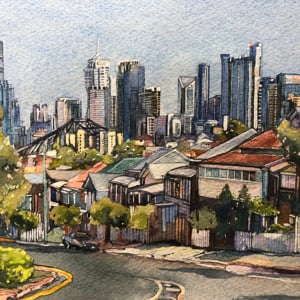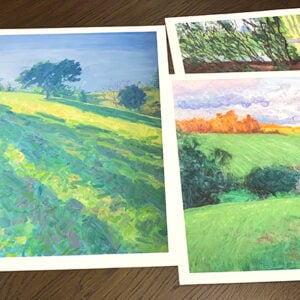Being able to take a great reference photo is an important skill for artists, even if you paint from life. You do not need to be a great photographer to take a great reference photo either.
Photography has come a long way in recent years and we can really take advantage of it to improve our art. It is amazing what you can now do with just your phone that you were not capable of doing a decade ago.
In this post, I will discuss what makes a great reference photo, things you should avoid and some general tips for taking a great reference photo.
- Is It Ok to Paint From a Photo?
- What to Look For in a Reference Photo
- What to Avoid in a Reference Photo
- Examples of Reference Photos I Would Want to Paint
- Examples of Reference Photos I Do Not Want to Paint
- Need Reference Photos?
- Want to Learn More?
- Thanks for Reading!
(Before diving into this post, make sure to pick up a copy of my free Landscape Painting Starter Kit.)
Is It Ok to Paint From a Photo?
Some artists will say you should not paint from a photo. I personally disagree and I believe photography can really complement you as a painter.
There are times when you are just not able to paint a scene from life. Maybe the light is quickly fading, the weather is changing, or your subject is moving. Photography allows you to capture elusive scenes so you can paint in your own time.
With that being said, painting from life is widely considered to be one of the best ways to learn painting so you should consider incorporating it into your training.
An interesting point to note is that great photos do not necessarily make great painting references. It is not the quality of the photo that counts but rather the composition of the photo and the inspiration it provides you.
What to Look For in a Reference Photo
So what exactly makes a great reference photo? In my opinion, a great reference photo should have:
Some points of interest (focal points) – First and foremost, your photo should have some points of interest to make it worth painting. If you paint from a photo that has no interesting features, then the chances are that your painting will also have no interesting features.
A strong value structure – A strong value structure is one of the first things I look for when searching for an interesting scene to paint. Value is considered one of the most important aspects of painting (read more about value here).
Here is a photo that I believe has a strong value structure. There are a few strong value groupings, and the image is clearly identifiable without color.

On the other hand, this photo does not appear to have a strong value structure. The values are not strongly grouped and it is a very scattered arrangement.

Decent photo quality – Whilst it is not important to have a professional quality photo to use as a reference, it helps to have a decent quality photo. With a decent-quality photo, you have the option of zooming in to see the more particular details. The colors will also be more accurate. The camera quality on most smartphones is usually more than sufficient to take great reference photos (you do not need an expensive camera to take great reference photos).
An interesting color harmony – A great reference photo should have a beautiful color harmony which you can draw inspiration from. It could be a stunning contrast between blue and orange (like in the photo below), or it could be a calming arrangement of analogous colors (like many of Claude Monet’s paintings of water lilies).

An interesting arrangement of space – I usually look for an interesting and balanced arrangement of positive and negative space. For example, in a cloudscape, I would be looking for an interesting arrangement of clouds (the positive space) amongst the blue sky (the negative space).
A photo I am inspired to paint – Paintings take time and effort to complete, so I am selective about what I paint. A great reference photo is a photo I am actually inspired to paint. There is no hard and fast rule as to what I want to paint. I could have a reference photo that ticks all the previous boxes and is technically a great reference photo, but I may not be inspired to paint it. I want to be able to look at a photo and see a finished painting at the end.
What to Avoid in a Reference Photo
Here are some things you should avoid in a reference photo:
Overexposure Or Underexposure – If a photo is too dark, it is underexposed. Details will be lost in the shadows and darkest areas of the image. If a photo is too light, it is overexposed. Details will be lost in the highlights and brightest parts of the image. Overexposure often occurs in bright sunlight during the middle of the day. Underexposure often occurs when there is not sufficient light (for example, you are taking a photo of a sunset). I find the best time to take reference photos is in slightly overcast weather, where the light is diffused. At this time all the colors seem to come out in full force. A way to combat exposure problems is to take numerous photos of the same scene at different exposures. This way you will get a range of photos and you can select which is most appropriate or use them together to create your painting. Or you could paint from life.
Too much clutter – If you take a photo of something you want to paint, have a think about the overall composition and try not to include too much unnecessary clutter. For example, if you want to paint a beautiful cliff ledge on the side of the ocean, don’t take a panoramic photo which includes the whole ocean. Take the photo you want to paint.
Unrealistic alterations (significantly photoshopped) – A great photo to photographers does not exactly make a great reference photo for painting. You should try to avoid photos that have been significantly altered and appear unrealistic. You want to paint a photo that looks like something you would see in life.
Copyrighted – Please do not paint from a photo unless you know it is free of copyright.
Examples of Reference Photos I Would Want to Paint
I will now go through some of my recent photos from Tasmania which I would like to paint.

This photo would make a great reference for a number of reasons:
- There is a beautiful contrast between the faint, blue background and the dark foreground of greens and earthy colors.
- There are many strong shapes.
- There are no repetitive or unnatural arrangements.
- There is a beautiful display of atmospheric perspective.

I love the turquoise water in this photo, which contrasts nicely with the oranges in the foreground. Some other great aspects of this photo for painting are:
- The tree branch acts as a leading line back into the painting.
- The mountains in the background demonstrate atmospheric perspective (related reading – How To Paint Mountains With Depth).
- There are lots of interesting shapes created by the landscape and the shadows.
Some issues I can see with this reference photo are:
- The horizon line is bisecting the photo. In general, I prefer to place dominance on either the sky or land/sea.
- There appears to be no dominant focal point.
- There is little variance in the sky.

I would like to paint this photo as:
- There is a calming reflection in the water.
- There is a beautiful color harmony, with greens, ochres, and grays.
- There is a strong value structure.
- The shapes are arranged in a pleasing manner.
- There are many leading lines that take you through the painting.
Examples of Reference Photos I Do Not Want to Paint

Some of the issues with this reference photo are:
- It appears overly cluttered.
- There is no strong focal point.
- The value structure is generally weak.
- The photo would be complex to paint (which is not an issue, but if you are going to paint a complex scene, then you want to make sure it is a worthwhile scene to paint).
- The color harmony does not interest me.

Whilst I don’t mind the composition of this photo, it appears overexposed in the lighter areas.

This location has the potential for some beautiful painting references, but not this reference photo. Some of the issues with this reference photo are:
- The composition is generally weak.
- The color harmony does not interest me. There is the potential for a beautiful harmony between the oranges of the rocks and the blues of the sky and water, but this is not really demonstrated in this photo.
- The value structure is not interesting.
Need Reference Photos?
If you are struggling with finding painting inspiration, then you may be interested in my Reference Photo Library which has a selection of my best landscape/seascape reference photos.
Want to Learn More?
You might be interested in my Painting Academy course. I’ll walk you through the time-tested fundamentals of painting. It’s perfect for absolute beginner to intermediate painters.
Thanks for Reading!
I appreciate you taking the time to read this post and I hope you found it helpful. Feel free to share it with friends.
Happy painting!
Dan Scott

Draw Paint Academy







Thanks again for the free tips!
No problem Deborah 🙂
Dan
Thank you very much for your great tip. I was thinking that I should buy a high end camera to take great photos for painting. But now with your advise I know what qualities I need in a photo and that I do not need to spend so much money for camera. As you said ” It is not the quality of the photo that counts but rather the composition of the photo and the inspiration it provides you.” I may add most of the time we need to change composition, color harmony and value structure of the photo in the painting. So a decent reference photo along with a plain-air color/value sketch from the scene will be sufficient.
Thank you for this valuable information, I now know what to look for when I take a photo strong value, focal point, and structure.
Great article. I’m trying to decide between two photos for a large-scale oil painting I’m having done… still haven’t decided, but this gives me something to think about. Thank you!
I am a recent artist with colored pencil. I am truly awful with picking out reference photos regardless of subject. This article continues to reinforce the positive objectives to look for in a reference photo, I need it all.
Thank you